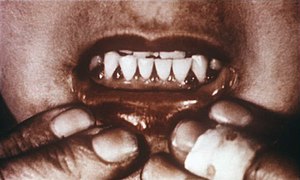
Scurvy

Scurvy is a disease resulting from a lack of vitamin C (ascorbic acid). Early symptoms of deficiency include weakness, feeling tired, and sore arms and legs. Without treatment, decreased red blood cells, gum disease, changes to hair, and bleeding from the skin may occur. As scurvy worsens there can be poor wound healing, personality changes, and finally death from infection or bleeding.A child presenting a 'scorbutic tongue' due to vitamin C deficiency.A child with scurvy in flexion posture.Photo of the chest cage with pectus excavatum and scorbutic rosaries. Scurvy is a disease resulting from a lack of vitamin C (ascorbic acid). Early symptoms of deficiency include weakness, feeling tired, and sore arms and legs. Without treatment, decreased red blood cells, gum disease, changes to hair, and bleeding from the skin may occur. As scurvy worsens there can be poor wound healing, personality changes, and finally death from infection or bleeding. It takes at least a month of little to no vitamin C in the diet before symptoms occur. In modern times, scurvy occurs most commonly in people with mental disorders, unusual eating habits, alcoholism, and older people who live alone. Other risk factors include intestinal malabsorption and dialysis. While many animals produce their own vitamin C, humans and a few others do not. Vitamin C is required to make the building blocks for collagen. Diagnosis typically is based on physical signs, X-rays, and improvement after treatment. Treatment is with vitamin C supplements taken by mouth. Improvement often begins in a few days with complete recovery in a few weeks. Sources of vitamin C in the diet include citrus fruit and a number of vegetables such as tomatoes and potatoes. Cooking often decreases vitamin C in foods. Scurvy currently is rare. It occurs more often in the developing world in association with malnutrition. Rates among refugees are reported at 5 to 45 percent. Scurvy was described as early as the time of ancient Egypt. It was a limiting factor in long distance sea travel, often killing large numbers of people. During the Age of Sail, it was assumed that 50 percent of the sailors would die of scurvy on a given trip. A Scottish surgeon in the Royal Navy, James Lind, is generally credited with proving that scurvy can be successfully treated with citrus fruit in 1753. Nonetheless, it would be 1795 before health reformers such as Gilbert Blane persuaded the British Royal Navy to routinely give lemon juice to its sailors. Early symptoms are malaise and lethargy. After one to three months, patients develop shortness of breath and bone pain. Myalgias may occur because of reduced carnitine production. Other symptoms include skin changes with roughness, easy bruising and petechiae, gum disease, loosening of teeth, poor wound healing, and emotional changes (which may appear before any physical changes). Dry mouth and dry eyes similar to Sjögren's syndrome may occur. In the late stages, jaundice, generalised edema, oliguria, neuropathy, fever, convulsions, and eventual death are frequently seen. Scurvy, including subclinical scurvy, is caused by a deficiency of dietary vitamin C since humans are unable to metabolically make this chemical. Provided diet contains sufficient vitamin C, the lack of working GULO enzyme has no significance, and in modern Western societies, scurvy is rarely present in adults, although infants and elderly people are affected. Virtually all commercially available baby formulas contain added vitamin C, preventing infantile scurvy. Human breast milk contains sufficient vitamin C, if the mother has an adequate intake. Commercial milk is pasteurized, a heating process that destroys the natural vitamin C content of the milk. Scurvy is one of the accompanying diseases of malnutrition (other such micronutrient deficiencies are beriberi or pellagra) and thus is still widespread in areas of the world depending on external food aid.Although rare, there are also documented cases of scurvy due to poor dietary choices by people living in industrialized nations. Vitamins are essential to the production and use of enzymes that are involved in ongoing processes throughout the human body. Ascorbic acid is needed for a variety of biosynthetic pathways, by accelerating hydroxylation and amidation reactions. In the synthesis of collagen, ascorbic acid is required as a cofactor for prolyl hydroxylase and lysyl hydroxylase. These two enzymes are responsible for the hydroxylation of the proline and lysine amino acids in collagen. Hydroxyproline and hydroxylysine are important for stabilizing collagen by cross-linking the propeptides in collagen. Collagen is a primary structural protein in the human body, necessary for healthy blood vessels, muscle, skin, bone, cartilage, and other connective tissues.Defective connective tissue leads to fragile capillaries, resulting in abnormal bleeding, bruising, and internal hemorrhaging.Collagen is an important part of bone, so bone formation is also affected. Teeth loosen, bones break more easily, and once-healed breaks may recur. Defective collagen fibrillogenesis impairs wound healing.Untreated scurvy is invariably fatal.
